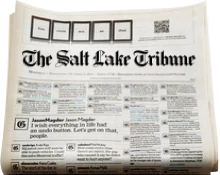This is an archived article that was published on sltrib.com in 2010, and information in the article may be outdated. It is provided only for personal research purposes and may not be reprinted.
On July 7, 1908, a laborer digging the foundation for John M. Knight's wagon factory on Salt Lake City's Social Hall Avenue bent to take a closer look at the rubble. Then he climbed out of the pit and went to find a policeman.
He had found a human skeleton, one showing signs of European origin, buried where no white cemetery had a right to be. An undertaker carefully gathered all the bones that could be found, together with bits of clothing, and took them to the police station. Investigators determined that the burial was decades old; if foul play was involved, they would be unlikely to solve it.
Without so much as a notice in any of the newspapers, the bones were boxed and put into storage at police headquarters. They lay forgotten there as the months passed.
The need for burial grounds arose almost as soon as Mormon pioneers arrived in the Salt Lake Valley. Less than a month after his July 1847 arrival, 3-year-old Milton Howard Therlkill drowned and was buried near his grandfather's wagons east of the pioneer fort then under construction. That fort has since become Pioneer Park, and Milton's burial site, along with other early graves, was rediscovered in 1986 in Salt Lake's Block 49.
In September 1847, George Wallace dug a grave for his small daughter on a hill overlooking the valley. That site became Salt Lake's official cemetery in 1851, with George Wallace as the first sexton.
Despite the existence of a city-supported cemetery, some families preferred to follow the custom of burying family members near their homes. Some of these small family cemeteries exist today -- the Mormon Pioneer Memorial (Brigham Young) Cemetery on 1st Avenue just east of State Street and the Kimball/Whitney Cemetery in the middle of the block on the west side of State Street midway between North Temple and First North are still maintained.
Others, like the small cemetery that once existed on Richards Street, on the site of the future City Creek Center, were closed long ago, their occupants moved to City Cemetery graves. Other burials occurred in family lots downtown. Some were moved after permanent cemeteries were established; others were forgotten, their locations lost to time and new construction.
And that is what happened, it turned out, in the case of the skeleton found in the basement of that wagon factory in 1908. The descendants of the woman buried there had in fact been searching for her for nearly half a century. Although they knew that she had been buried in her own garden, no marker had been placed. When they tried to find her casket in the 1860s, they could not locate it.
The search was renewed in the 1880s by a grandson, John. He knew that his grandmother had lived somewhere northeast of State Street and First South, but construction on that block had obliterated all pioneer landmarks. He spent a small fortune probing wherever property owners would allow him to dig test holes. It was no use, though, and he finally gave up.
Then in 1910, John's records came into the hands of his cousin, Oscar, and Oscar renewed the search. His questions uncovered the story of the skeleton found in the basement, and Oscar went to the police station to ask for details. He described the location of his grandmother's home, and her height and weight. It took some searching to relocate the box, but in March 1910, it were found. Everything about the bones and where they were found pointed to their identity: Phebe Morton Angell, mother of architects Truman and Solomon Angell, and of Mary Ann Angell, wife of Brigham Young. Phebe had arrived in the Valley in the summer of 1848 and died in the fall of 1854, at age 68.
The family announced plans to bury Phebe -- at last -- next to members of her family. The lost had been found.
Ardis E. Parshall
is a Utah historian. He welcomes feedback from readers and can be reached at AEParshall@aol.com.

